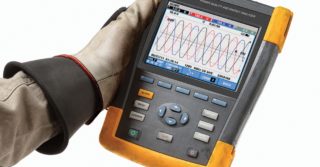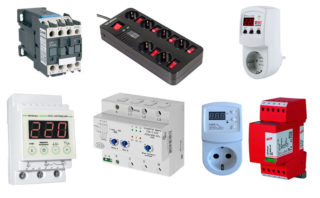The contract between the consumer and the energy supply company always spells out the obligations of the supplier. One of the most important indicators that deserves attention is the quality of electrical energy. But before making conclusions about the service provided, you need to find out what is meant by this term and what values it covers. Electricity indicators are set in accordance with applicable regulatory documents.
What is power quality?
Quality indicators for each type of electric line are set differently. Actual parameters must fully comply with those specified in the regulatory documentation. It is this feature that determines the quality of the service provided.
Changes or transformations of PCEs arise as a result of resource loss during transportation over long distances, electromagnetic phenomena or abnormal increases in loads on the trunk.
To assess the quality of electricity, it is necessary to measure the main indicators. You can study them in detail in the regulatory documents of GOST No. 13109-97.
What affects the characteristics of the mains
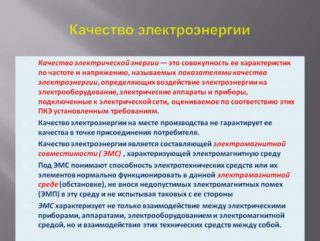 The quality of electricity is influenced by a fairly large list of factors:
The quality of electricity is influenced by a fairly large list of factors:
- regular voltage drops as a result of connecting large loads;
- icing of supply lines;
- increase in air humidity;
- the quality of electric lines, the end of their operational period, their failure;
- at sea stations, the tides are taken into account.
When it comes to wind farms, changes in the direction and strength of wind flows can be detrimental to the quality of electricity.
What happens when you deviate from normal diet
The power, productivity and service life of electrical devices, especially on an industrial scale, directly depend on the quality of the supplied energy resource. The decrease in the efficiency of highways leads to an increase in the consumed electricity. In the engines of devices, the torque decreases, the lighting fixtures regularly flicker, all types of lamps quickly fail.
Researches in the field of physics have long shown that with a constant load on the engine, a decrease in voltage leads to a rapid increase in current, which negatively affects the performance, productivity and service life of household appliances and other electrical devices. This leads to the burning of electronic circuit boards, wires with insulating material can melt.
Power Quality Assessment Criteria
 A large number of different indicators affect the assessment of the quality of electricity.
A large number of different indicators affect the assessment of the quality of electricity.
- voltage deviation;
- voltage fluctuations;
- impulse voltage;
- frequency deviation;
- voltage dip;
- dose of flicker;
- coefficient of temporary overvoltage.
Voltage deviation
The value is calculated by a special coefficient that characterizes the steady-state deviation in relation to the nominal. You can verify the proper quality using a special measuring receiver of electricity.
Deviations of voltage from the norm are recorded with large losses during the transmission of a resource over long distances or overloading of the trunk.The maximum acceptable indicators are 10%.
Voltage fluctuations
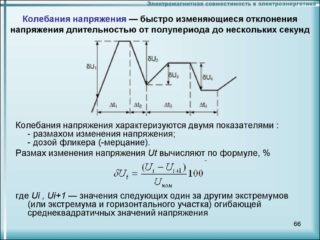 The value characterizes the deviation of the amplitude of the oscillations of the electric current in the wires. Voltage fluctuation is an integral quality parameter. To calculate it, you will need to first calculate:
The value characterizes the deviation of the amplitude of the oscillations of the electric current in the wires. Voltage fluctuation is an integral quality parameter. To calculate it, you will need to first calculate:
- duration and frequency of deviations;
- dose of fluctuations;
- scope of change.
To calculate the parameters, special measuring equipment of high accuracy will also be required.
Impulse voltage
The value manifests itself in the form of a short increase in the amplitude of electricity. As a rule, the cause of such jumps is switching processes or bad weather outside the window. Such network conditions are characterized by unpredictability, therefore, the regulation of impulses is not provided.
Frequency deviation
This parameter is set to 50 Hz in public networks. Regulatory standards allow a decrease or increase in frequency by 2-4%. If the permissible deviations are exceeded, failure of the electrical equipment is observed, the electric generators fail.
Voltage dip
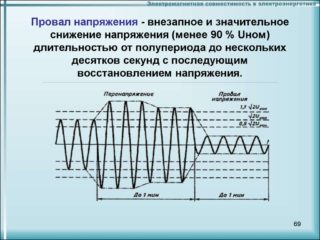 The concept is characterized as a significant decrease in amplitude with subsequent recovery in a short period of time. The main triggering factors are a sharp increase in load or short circuit.
The concept is characterized as a significant decrease in amplitude with subsequent recovery in a short period of time. The main triggering factors are a sharp increase in load or short circuit.
This indicator is described by the following characteristic features:
- deviation rate per unit of time;
- force of subsidence of tension - in some cases it can tend to zero;
- duration.
The voltage dip also has a random nature of occurrence, therefore, regulation is not provided.
Flicker dose
The parameter shows what effect the flickering of lighting devices as a result of changes in the parameters of electricity has on the human body. The value is calculated using special measuring equipment.
Overvoltage ratio
This term refers to how much the actual amplitude is above acceptable values. The main triggering factors are switching processes and short circuit.
How to ensure proper power quality
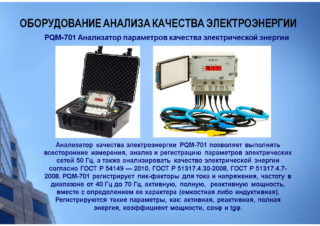 Before you start the test yourself, you need to take into account the fact that the quality indicators of electricity should be recorded by representatives of the relevant organizations. Only on the basis of the results of the act of work can claims be made to the supplier.
Before you start the test yourself, you need to take into account the fact that the quality indicators of electricity should be recorded by representatives of the relevant organizations. Only on the basis of the results of the act of work can claims be made to the supplier.
To check all the required parameters, additional use of special measuring equipment will be required. Some values can be calculated using a multimeter:
- failures;
- overvoltage and phase imbalance;
- established deviation.
The abnormal operation of household appliances and electrical appliances can also indicate deviations from the norm.
Types of protection against unpredictable changes in network settings
The energy supplying company must take care of the proper quality of the delivered services, which comply with the established regulatory documents. But at the same time, each homeowner can personally protect their household appliances from power surges with special types of equipment:
- Uninterruptible power sources are able to maintain the working condition of some types of household appliances for a given time. For example, connecting such a device to a computer allows you to correctly complete its work and save all the required files.
- Equipment designed to protect against voltage surges. The principle of operation is similar to the operation of a relay. If one of the parameters of the electric circuit reaches critical levels, the room is automatically de-energized.
- The voltage stabilizer controls so that the voltage does not go beyond the specified parameters.Ensures proper quality of electricity, but provided that the deviations do not exceed 35%.
It is recommended to purchase equipment designed to protect household appliances in specialized stores. The accompanying documentation and warranty card must be attached to the electrical device.
